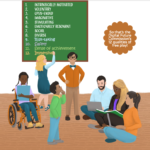
I’m rereading Dr. Dan Siegel’s book Brainstorm: The Power and Purpose of the Teenage Brain. Dan writes:
People who use their minds to reflect on the inner nature of their mental lives grow circuits in the brain that link widely separated areas to one another [think amygdala, limbic regions, prefrontal cortex]. This linkage, called “neural integration,” creates the coordination and balance of the nervous system. Another term that some researchers use for this is “self-regulation.” In the nervous system, regulation is created through neural integration.
This morning I found myself one click away from automatically checking email. My finger was in motion towards the Mail icon at the bottom of my iPhone screen when I noticed the automatic movement, and stopped.
What led me to notice and stop?
I talk to myself…a lot.
Not just random conversations. Deliberate conversations. Conversations that create the conditions for reflection…curious, non-judgmental, kind, with plenty of humor. In these focused conversations with myself, I clarify my visions and values—in particular, what I care about, what I’m trying to do, and how I want to/need to spend my time to bring that new reality forward. I review my current reality (kindness is key here). The incoherences between my visions and values identified and my life being lived get pretty clear at this point—sometimes glaringly as in the case of how I was relating to “news.” Out of this reflective process, I design experiments to try—experiments to help me move in the direction of my visions and values. And then I circle back for another conversation in a week or a month (cycle length varies) to evaluate the effectiveness of that particular experiment and what I need to adjust.
How are you talking to yourself about technology in your life? Are you saying, “I don’t have time to talk to myself about technology”? I hear you. I say that to myself too. But I’ve come to understand that these deliberate conversations with ourselves are as necessary as exercise if we are to help our children thrive in the techno landscape we inhabit today. Because just like not getting enough exercise, without these conversations, our health and well-being suffer. Our children, tweens, and teens are learning how we’re living with technology in our own lives.
These conversations with ourselves become the foundation for great conversations with our kids about technology.
Start simply. It doesn’t have to take a lot of time.
Here’s a basic structure to help you get rolling.
Schedule a meeting with yourself on your calendar for 20 minutes. If you can do 30, great.
Choose your tools (Tools might just be an old-school pen and a small notebook, might be Evernote or iAWriter. Pen/notebook has advantage of minimizing distractions presented by a phone, tablet, or laptop.)
Show up. This is more challenging than it sounds. (Think of this as exercise—which it is. It’s self-regulation strength training.)
Ask yourself a few questions to begin and write your responses. For example:
- What are my top 3 values and how are these inspiring my decisions and choices this week?
- Where do I need to put my attention that I’m not?
- What has kept me from putting my attention where it’s most needed?
- How is my use of technology helping and/or hindering me in bringing forward my visions?
- What’s one small experiment I can try this week to move towards technology “helping” instead of “hindering”?
- How will I evaluate the experiment’s results?
Schedule another 20-minute conversation in a week.
Review what you wrote at least once before your next conversation.
Enjoy the process. ;D
I’m guessing you may come up with some really great questions for yourself. I’d love to hear them. Use the Contact form in the About section to share with me.


